On a recent sunny winter morning, Huang Yo-chien (黃友謙), one of the few remaining traditional temple painters in the country, was filled with nostalgia as he began painting door gods on the main entrance to the Dongjia Beijhih Temple (東甲北極殿) in the Penghu archipelago.
It was at this centuries-old temple that the 77-year-old painter of temple wall and door decorations began his career 60 years ago, as an apprentice to his artisan father.
The temple in the Dongjia District (東甲) of Magong (馬公), Penghu County’s capital, was undergoing a major renovation at the time and his father, Huang Wen-hua (黃文華), was in charge of the temple’s decorations, including paintings and carvings.
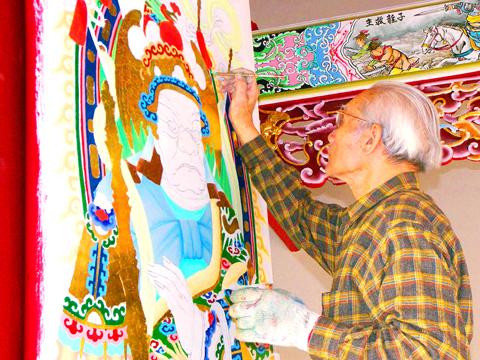
PHOTO: CNA
Six decades later, Huang Yo-chien is doing the same work as his father — painting door gods on the temple’s main entrance and refreshing the colors of its paintings — but there are few left to carry on this highly respected traditional art form that painters like Huang have seen as a way of respecting local gods.
Driven by pressures to earn more money and complete jobs quickly, fewer young people are entering the profession, even if the nation’s 11,651 temples are still important places in Taiwanese society.
The art of temple painting was once learned through patience and years of practice, said Chiang Shao-ying (江韶瑩), a professor at Taipei National University of the Arts.
But the current business environment deters the meticulous learning of the craft, as temple paintings and decorations have become just another component in bids for complete temple construction projects.
With project budgets cut to the bone, contractors often allocate only a tiny share of the overall budget to the paintings, leaving artisans unwilling to do the painstaking work of their predecessors, Chiang said.
Temple painters were once relatively well paid compared with other professions, but nowadays they are likely to earn only NT$200,000 to NT$300,000 per project, which normally takes weeks or even months to complete.
The lower budgets have also spurred changes in temple decoration techniques that have discouraged the cultivation of temple artists.
Over the past decade, nearly all newly built temples in Taiwan have been adorned with bas reliefs, with door gods cut into the surface of their wooden gates by machines rather than being painted, shortening construction time and saving touch-up costs.
As the nature of the business and the work has changed, so has the attitude of some painters. While once truly devoted to their profession and seeing themselves as fulfilling a commitment to the gods, many today are mere contractors without any spiritual or emotional attachment to the job they have been hired to do.
That attachment compelled masters of the trade like Huang Yo-chien and his father to take an uncompromising approach to their work, but Huang also credits his father’s open-mindedness for his artistic development.
“He allowed his apprentices to develop innovative painting skills and foster their own styles, “ Huang Yo-chien said.
His father, he said, accepted his experimentation with Western oil painting and incorporating oil painting techniques into temple painting, innovative techniques that enabled him to stand out and start a new trend in the field.
Now considered one of the nation’s most renowned door god painters, Huang Yo-chien’s works can be seen throughout Taiwan, including at Sanfu Wangye Temple (三府王爺) in Keelung’s Hepingdao (和平島) and Yitien Temple (義天宮) in Sanchung (三重), Taipei County.
But his main body of work is in Penghu, which boasts the nation’s highest temple density.
At least 70 percent of Penghu’s roughly 200 temples are decorated with his character paintings.
The most difficult part of temple painting is painting the facial expressions of the door gods, whose role is to protect the temple and its worshipers from evil spirits.
“If your master dares to allow you to paint a door god’s face, it means that your professional skills have reached a level of maturity and that your apprenticeship may come to an end,” he said.
Wang Wen-liang, a fine arts teacher at Magong Senior High School who is versed in Penghu’s temple art development, said Huang Yo-chien is a master at capturing door gods’ facial expressions, the eyes in particular.
Huang regrets that the temple painting profession is fading fast in Taiwan, especially as there is nobody to follow in his footsteps.
Huang says age has caught up with him and the Dongjia Beijhih Temple door gods will be his last work.
“I’ll retire when it is completed,” said Huang, who estimates he has painted more than 150 temples over his six-decade career.
It is a fitting final assignment for Huang, as his career started and will end at one of the nation’s oldest temples that bears witness to the long history and development of the art form.
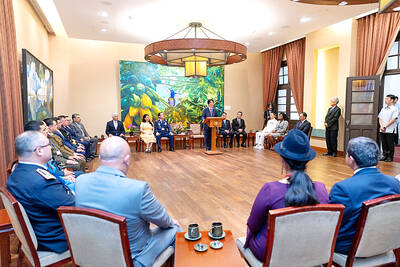
Costa Rica sent a group of intelligence officials to Taiwan for a short-term training program, the first time the Central American country has done so since the countries ended official diplomatic relations in 2007, a Costa Rican media outlet reported last week. Five officials from the Costa Rican Directorate of Intelligence and Security last month spent 23 days in Taipei undergoing a series of training sessions focused on national security, La Nacion reported on Friday, quoting unnamed sources. The Costa Rican government has not confirmed the report. The Chinese embassy in Costa Rica protested the news, saying in a statement issued the same
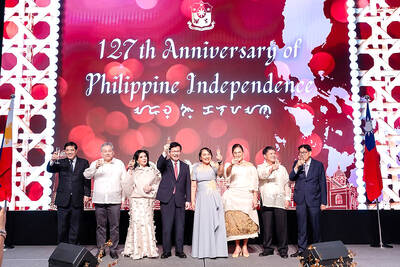
Taiwan is to extend its visa-waiver program for Philippine passport holders for another year, starting on Aug. 1, Minister of Foreign Affairs Lin Chia-lung (林佳龍) said on Friday. Lin made the announcement during a reception in Taipei marking the 127th anniversary of Philippine independence and the 50th anniversary of the establishment of the Manila Economic and Cultural Office (MECO) in Taiwan, the Ministry of Foreign Affairs said. The decision reflected Taiwan’s commitment to deepening exchanges with the Philippines, the statement cited Lin as saying, adding that it was a key partner under the New Southbound Policy launched in 2016. Lin also expressed hope
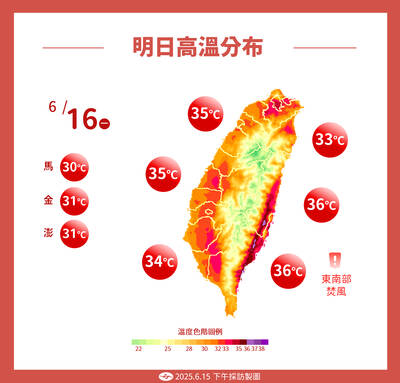
Temperatures in New Taipei City’s Sindian District (新店) climbed past 37°C yesterday, as the Central Weather Administration (CWA) issued heat alerts for 16 municipalities, warning the public of intense heat expected across Taiwan. The hottest location in Taiwan was in Sindian, where the mercury reached 37.5°C at about 2pm, according to CWA data. Taipei’s Shilin District (士林) recorded a temperature of 37.4°C at noon, Taitung County’s Jinfeng Township (金峰) at 12:50 pm logged a temperature of 37.4°C and Miaoli County’s Toufen Township (頭份) reached 36.7°C at 11:40am, the CWA said. The weather agency yesterday issued a yellow level information notice for Taipei, New
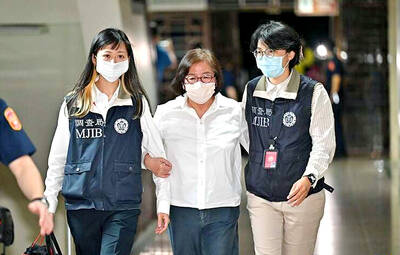
CASE: Prosecutors have requested heavy sentences, citing a lack of remorse and the defendants’ role in ‘undermining the country’s democratic foundations’ Five people affiliated with the Chinese Nationalist Party (KMT), including senior staff from the party’s Taipei branch, were indicted yesterday for allegedly forging thousands of signatures to recall two Democratic Progressive Party (DPP) lawmakers. Those indicted include KMT Taipei chapter director Huang Lu Chin-ru (黃呂錦茹), secretary-general Chu Wen-ching (初文卿) and secretary Yao Fu-wen (姚富文), the Taipei District Prosecutors’ Office said in a news release. Prosecutors said the three were responsible for fabricating 5,211 signature forms — 2,537 related to the recall of DPP Legislator Wu Pei-yi (吳沛憶) and 2,674 for DPP Legislator Rosalia Wu (吳思瑤) — with forged entries accounting for